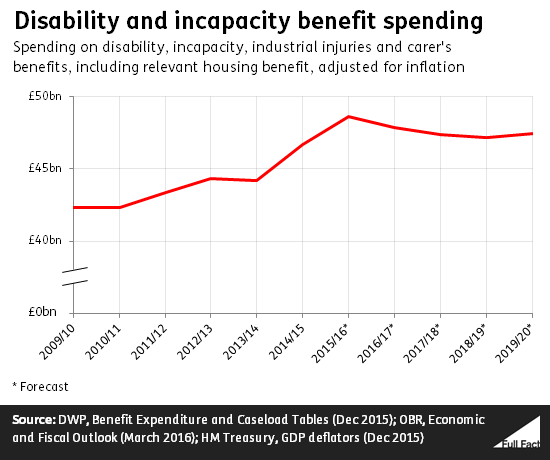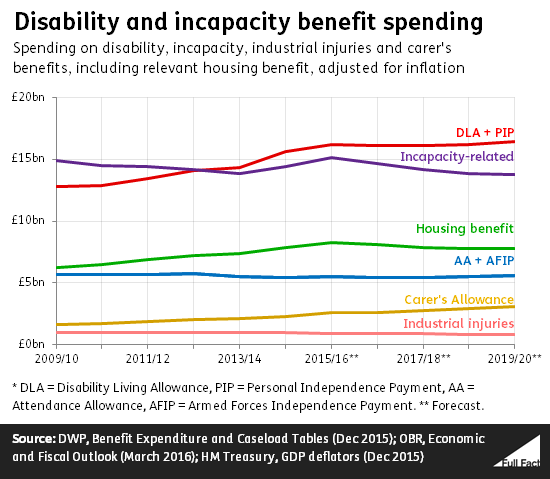“Even after the U-turn over cuts to personal independence payments, disabled people are set to see a real-terms cut of £1.2bn a year across this parliament.”
Owen Smith, Shadow Work and Pensions Secretary, 24 March 2016
“Spending on the main disability benefits will increase over the course of this parliament.”
Department for Work and Pensions spokesperson, 24 March 2016
There are a variety of benefits for people who are disabled or incapable of work and different combinations of these have been referred to as ‘disability benefits’.
Owen Smith is talking about all disability, incapacity, industrial injuries and carer’s benefits. Spending on these will fall by £1.2 billion by the end of the current parliament once inflation is considered. That doesn’t mean it will fall by that amount in every year of the parliament as Mr Smith appeared to suggest.
The government told us it was referring to spending on Personal Independence Payments (PIP), Disability Living Allowance (DLA) and Attendance Allowance (AA). Spending on these will rise slightly ahead of inflation over the Parliament.
This doesn’t tell us about how spending on individuals has and will change.
All the figures referred to are in 2015/16 prices, unless otherwise stated.
Spending on all disability and incapacity benefits
Spending on all benefits connected to disability and incapacity for work was £42.3 billion in 2010/11, adjusted for rising prices, compared to around £100 billion spent on welfare outside pensions.
It will be £48.6 billion this year and £47.4 billion by 2019/20. That’s an average fall over the next five years of £295 million a year.
That’s based on new forecasts from the Office for Budget Responsibility, combined with existing information from the Department for Work and Pensions (DWP).

It would have been £1 billion less by 2019/20 if the changes to Personal Independence Payment introduced in the budget had been made. They’ve since been withdrawn.
Spending on Disability Living Allowance and Personal Independence Payments
Spending on DLA, PIP and AA, counted in the government’s calculations, is expected to go up slightly. It will increase from about £21.7 billion in 2015/16 to £21.8 billion in 2019/20.
It won’t increase by as much as has been the case over recent years.

If the government had gone ahead with its plans to change PIP, total spending on PIP and DLA would have fallen in real terms.
What this means for individuals
Looking at overall spending doesn’t tell us about how people with disabilities have been affected or how they will be affected.
The OBR’s projections following the budget this year focus on DLA and PIP, which is what we’re covering here.
The government said the replacement of the Disability Living Allowance with the Personal Independence Payment was designed mainly to support “disabled people who face the greatest challenges to living an independent life”. It was expected to reduce the number of people claiming the benefit and to reduce expenditure from what it would otherwise have been.
But it hasn’t done that by as much as had been expected.
More existing DLA claimants have ended up claiming PIP than was predicted and more of those people have ended up being awarded the enhanced payments.
But forecasts for the next five years suggest the number of people claiming DLA or PIP will decrease.
The average spend per claimant will continue to rise, but it won’t increase by as much as has been the case. Average spending per claimant will rise by 6%, compared to 12% between 2009/10 and 2014/15.
That doesn’t mean that the ‘average’ represents the typical person’s experience, as it just takes overall spending and divides it by the total number of people expected to claim.

